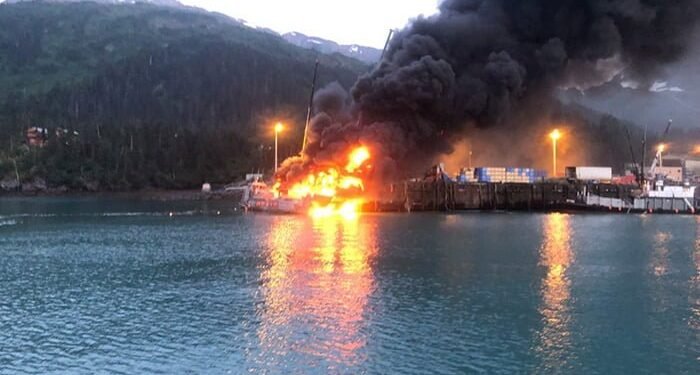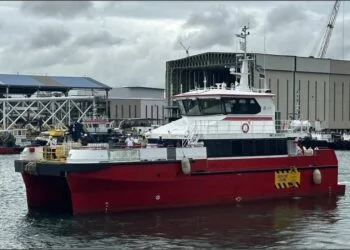
Coast Guard photo shows fire burning at Delong Dock, Whittier, Alaska, after the explosion. [Image: Coast Guard Sector Anchorage]
The National Transportation Safety Board has issued its report into a July explosion that killed the sole crewmember on a barge was moored at the Delong Dock in Whittier, Alaska. The vessel was serving as a platform for pumping fish cargo ashore from fishing vessels and tenders that came alongside. It also provided diesel fuel and gasoline to the fishing vessels.
The NTSB report says that the 98 foot long barge, the Alaganik was originally built in 1974 as a small integrated tugboat and barge, and the two units that made up the combination were purchased by the current owner — described only as “a private citizen” — in 2006. Following a grounding in 2013, the owner removed the engines from the tugboat and permanently welded the tugboat and barge together.
The original barge portion of the Alaganik was composed of a center section, pontoons on either side of the center section, and a line locker forward of the center section used for storing gear. The fuel supplied to fishing vessels from the Alaganik was stored in four permanently installed 1,250-gallon capacity fuel cargo tanks located fore and aft in the pontoons on the barge.
The barge was carrying diesel fuel when it arrived in Whittier, but it did not have gasoline. Therefore, at about 4 p.m. on July 7, the vessel took delivery of 1,001 gallons of gasoline from a fuel truck on shore. The gasoline was loaded into one of the vessel’s four fuel cargo tanks, the forward portside tank, and the Alaganik crewmember signed for receipt of the fuel when the transfer was completed at 4:35 p.m. The three remaining fuel cargo tanks—on the port side aft, starboard side aft, and starboard side forward—contained 875, 850, and 910 gallons of diesel fuel, respectively.
“At 2339 that night,” says the report, “an explosion occurred on the Alaganik. Witnesses stated that the ensuing fire was initially concentrated on the port side of the vessel, forward. Photographs of the vessel taken just after the explosion show flames concentrated on the port side, with the vessel listing to port. The fire quickly spread to the pier, and fuel that escaped into the water around the barge also burned. The fire engulfed the vessel, along with three boom-crane trucks and other equipment and gear on the pier. Shore-based firefighters responded to the pier and began fighting the fire.
“A Good Samaritan vessel that had been moored to the dock near the Alaganik got under way, threw a grappling hook over the rail of the barge, and towed the barge away from the pier. The Alaganik sank shortly thereafter, at 0229. The firefighters continued to fight the fire on the pier and reported that it was extinguished at 0250 on July 8. A hatch from the port side of the vessel was later found on the dock several hundred feet from the vessel’s berth.”
The report says that witnesses reported seeing the lone crewmember on board the Alaganik walking aft from the bow toward the stern of the vessel just before the explosion. However, in the aftermath of the explosion, he could not be located.and the search was suspended after 17 hours. His body was recovered eight weeks later in a secluded cove about 400 yards to the northeast of the accident site.
In its analysis of the incident, the NTSB report says that toxicology findings indicated that the crewmember had used methamphetamine and marijuana at some time prior to the accident, but it could not be determined whether he was impaired by any of the effects of those drugs at the time of the explosion. The report also says that the man was a cigarette smoker, but that it could not be determined that a cigarette was the source of the ignition leading to the explosion
The National Transportation Safety Board determined that the probable cause of the explosion on board the barge Alaganik was the ignition, from an undetermined source, of gasoline vapor from a fuel cargo tank, which became entrapped within the vessel’s port pontoon compartment.
- Download the complete NTSB report HERE.














